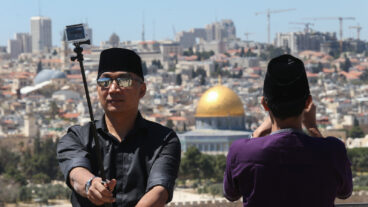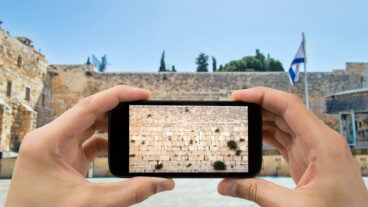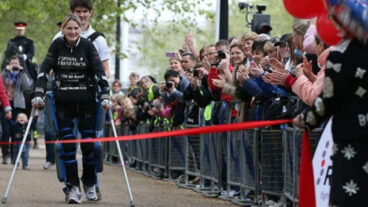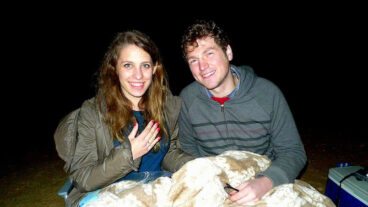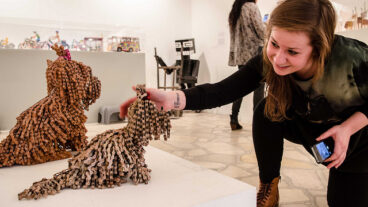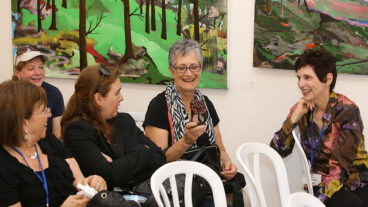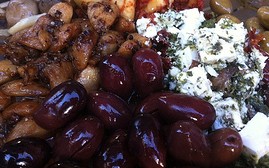Twelve young karate students discover they have a common language. We weren’t certain, at first, that we should be sending Adam, at 10, off to Greece, and a two-and-a-half hour drive from Athens at that, in the company of people he barely knew. But it turned out that Danny Hakim, the organizer, is the cousin by marriage of our rabbi’s sister’s husband. Almost family!
So off we went, my karate-loving blue-belted son and me, to meet the other five Israeli children, and the six Palestinians from the northern Jerusalem neighborhood of Isawiyah, and the various accompanying adults, for a pre-trip briefing next to the swimming pool on the roof of the Dizengoff Center in Tel Aviv. Evidently I wasn’t the only one who didn’t know, and barely believed, that there was a pool up there at all. The Palestinians arrived an hour late, having apparently been waiting at a more conventionally located pool at ground-level nearby.
It was a little awkward at first – not just unfamiliar faces, but unfamiliar faces from across the great divide. Two of the Israeli kids were Arabs, from the Neveh Shalom “peace village,” but they were too shy to say much to the Palestinians, few of whom seemed to know much Hebrew. We all introduced ourselves, standing briefly in turn; that barely broke the ice. But then Danny suggested they do a well-known “kata” – a carefully choreographed series of moves – side by side.
They lined up, Adam and three of the Palestinians, gave the deliberate, respectful bow that precedes blurring karate action, and then, astoundingly to me, proceeded to perform the sequence with absolute synchronicity – first-time colleagues who looked for all the world as though they had been training together for years. And when they had finished, the quartet grinned at each other in shy appreciation: They did have a common language after all.
A week afterwards, they set off for Delphi together – pioneers in what Hakim hopes will become a much larger “Budo for Peace” initiative, designed to bring together young white-suited practitioners mainly but not only from war zones, in the hope of instilling in them the budo values of personal stability and self-discipline, courtesy and respect, and the ability to live in harmony and balance with the rest of the world. (Forget the TV images of black-belted brutes whacking, chopping and kicking each other: Budo, the Japanese group term for martial arts, translates literally as “the way of stopping conflict.”)
This first, trial event was not without its hiccups; a group from Kosovo never made it because of complications over their visas. But three kids and their trainer from Cyprus did arrive. Three budo masters traveled from Japan at their own expense – to teach technique and philosophy. Another coach came over from Beirut. The mayor of Delphi greeted them. The Japanese ambassador sent a letter of support. They made positive headlines.
The timing and location were anything but coincidental. This was a trailblazing effort to promote mutual understanding, as envisaged by Pierre de Coubertin, reviver of the Games, in his 1896 Olympic Charter. And it was presented at the ancient home of the Pythian Games, forerunner of the Olympics, just before the commercialized, drug-debased extravaganza of their modern reenactment.
In ancient times, under the “Olympic Truce,” warring parties would lay down their weapons two weeks before the Games, and concentrate for an all too brief a period on peaceful prowess and competition. Nowadays, notwithstanding Yasser Arafat’s recent disingenuous pledge to rekindle the tradition, even a two-week respite is too much to reasonably hope for.
When they emerged into the arrivals hall at Ben-Gurion Airport four days later, they were easy in each other’s company. On both sides, they’d been surprised at “how nice” the Israelis/Palestinians were, and how good at karate. Reunions are being tentatively planned, and other, bigger, possibly Japanese-government-funded, international budo festivals.
And yes, it is pathetic that it required a determined initiative by a relatively new Australian immigrant, Hakim, and an independent-minded Palestinian counterpart, Abdel (who runs his hugely popular karate club in the entrance hall of a school and who stepped in when another Palestinian coach got cold feet), and outside sponsorship, and fairly complicated logistics, for Adam and Daniel and Fady and Asmaa and the rest to learn that there are nice Israelis and nice Palestinians and that they share plenty of common interests and concerns.
But after almost four years of this bitter, futile round of conflict, with near-total physical separation having replaced almost every opportunity for casual coexistence, the sad truth is that isolation and ignorance have revived the worst stereotypes and hatreds, on both sides. And these minor, modest, efforts at interaction, the kinds of small-scale, grass-roots dialogue we thought we had outgrown 20 years ago, are among the only means currently available to counter the trend. Several residents of Isawiyah have been arrested for alleged terrorist activity in recent years. Now, at least, there are 12 small untainted children who will not easily be led down the path of ignorant viciousness. May it be 120 next year. And 1,200 the year after that.
(Reprinted with permission from The Jerusalem Report)




